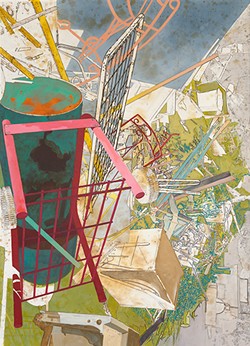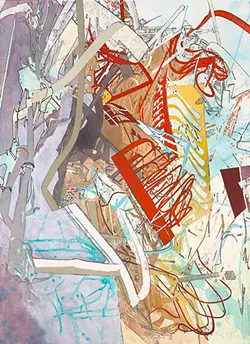Crisis. It's on everybody's minds these days. It's certainly on Susan Brenner's mind. She's a painter and retired UNC Charlotte art professor whose new exhibit, The State of Things, grapples with society as it lurches to the brink.
"I want to talk about our tendency towards chaos," Brenner says of the show, which opens January at her alma mater's Rowe Galleries and runs through February 7. "I would say that our current politics are in constant crisis.
"My natural desire is to create order and beauty," she adds, "so there's a kind of give and take in the work between this expression of upheaval and my attempt to make sense of it — or to manage it."
As if to illustrate this point, as soon as Brenner closes The State of Things, a meditation on collapse and divisiveness, she will debut another project — one that celebrates community and the things that bring us together. Two public art pieces, which the 67-year-old artist completed for the LYNX Blue Line extension, are scheduled to be unveiled in March when the University City Boulevard and J.W. Clay light rail stations open.

- Susan Brenner. (Photo by Jeff Cravotta)
In her exhibition and public art, Brenner walks a tightrope between two poles. One is the shared dreams and ideals that bind us together as a people, and the other is entropy's inexorable march to dissolution.
In her work, Brenner jumbles and juxtaposes photography, digital imaging, line drawing and painting. The result is multi-textured paintings that are dense and hypnotic. Images that are either biological or mechanical — or a combination of the two — leap out at the viewer from the coiling lines of her canvasses before merging back into the labyrinthine lines of her composition. It's an interactive effect which caused one reviewer, Joshua Peters writing for Charlotte Viewpoint, to compare Brenner's works to an abstract Where's Waldo? page.
Brenner laughs at the comparison, though she admits, "I understand where that description is coming from."
One description of her work that she does take issue with, however, is "abstract expressionism." She prefers the term "semi-abstract," because of her work's illustrative aspects.
"There are things that you can recognize as well as things you can't, but I'm [pointing] you in a direction," Brenner says. She believes most viewers will perceive a degree of instability in the forms she paints. They will get the feeling that shapes and lines are active and in motion. There is room for interpretation, she offers, but each piece also provides a framework for that interpretation. "It's not completely wide open," Brenner says.
The social critique inherent in The State of Things always has been a part of Brenner's work. In 1991, after earning a Master of Fine Arts at the University of Southern California, Brenner started creating work that was based on existing images and representations of women in the culture.
"I was appropriating images that already existed and then using them to provide commentary," she says. "There were references to books, literature and art history." Soon she started creating her own images rather than commenting on ones that existed.

- Artwork by Susan Brenner.
"I suppose I'm still critiquing culture in a certain way," Brenner says. "But I'm not taking something out of the media or out of art history; I'm going out to scrap metal yards and shooting pictures."
Nowadays, the artist's process begins with those photographs Brenner takes herself. She then digitally turns them into line drawings. In a previous show, Natural Histories, which exhibited at Central Piedmont Community College in 2015, the drawings were manipulated extensively so that they bore scant resemblance to the original photographs.
By contrast, the photos used in The State of Things remain in the line drawings. "It's more or less representative of what I photographed," Brenner says. Once she is satisfied with her digital line drawings, she then paints bold colors over them in combinations that are sometimes unsettling.
In previous shows, such as Natural Histories and After Migrations, from 2007, Brenner's shapes and lines suggested biological forms. "I think I tend toward making that type of image — things that are biomorphic," she says. But for The State of Things, Brenner turned toward more industrial shapes. "I wanted to work with forms that are obviously manmade or machine made, things that had harder edges," she says. "There's a mechanical aspect to the work — all those straight lines and angles."
With lines so straight and sharp they look like light glinting off a knife's edge, Brenner's industrial-strength images convey a world in constant accelerating turmoil. "I pay a lot of attention to the news and what's going on in the world," she says.
There may be growing awareness of chaos today, because of social media and the 24-hour news cycle, but there is more at play in Brenner's work than just increasing awareness. "I think with our current politics, the world is in much more uproar than is normal," she says.
If Brenner's images in The State of Things represent the world's harsh and hard-edged yang, her public work for LYNX points to our supportive and cooperative yin. Brenner was contracted to start the long-gestating project in 2009, but didn't begin the work until the following year. It took another seven years for her to complete the project.

- Artwork by Susan Brenner.
The project is a pair of glass works Brenner did for elevator stairway towers, one at the University City Boulevard station and the other at the J.W. Clay terminal. At each location, the elevator takes LYNX riders up to a bridge that crosses the street to the parking deck. To create the glasses, Brenner followed a process similar to her methods for her paintings and drawings.
"Both images are based on Charlotte's tree canopy," she says. "I photographed trees in winter when they were without leaves so I could focus on the structure of the branches."
The piece at J.W. Clay resembles a tree constructed from triangles, each triangle filled with intricate details containing linear elements and colors. It's called "The Red Tree," Brenner says, because she was inspired by North Carolina's red clay soil.
The triangle represents Charlotte's different neighborhoods as well as the functions of the tree, Brenner explains. She likens a tree's branching structure to public transportation, which connects different parts of the city and creates community.
"The branching structure is like the circulatory system of the tree, and it's similar to the animal and human circulatory system," Brenner says. "So transportation is like the lifeblood of the city."
Plus, she adds, Charlotte's trees add so much to the city's beauty.
At the University City Bouelvard station, Brenner's glass work is called "Waterfall." It's also based on the tree photographs, she says, but its tree-like properties are not as obvious as they are at J.W. Clay. Here, Brenner combines the tree forms with layers of color to create a fluid and watery piece. Quite simply, it's beautiful, she says.
"With both of these, I just wanted to make pieces that were happy," Brenner says. "I hope they will brighten the day of anybody who interacts with them."